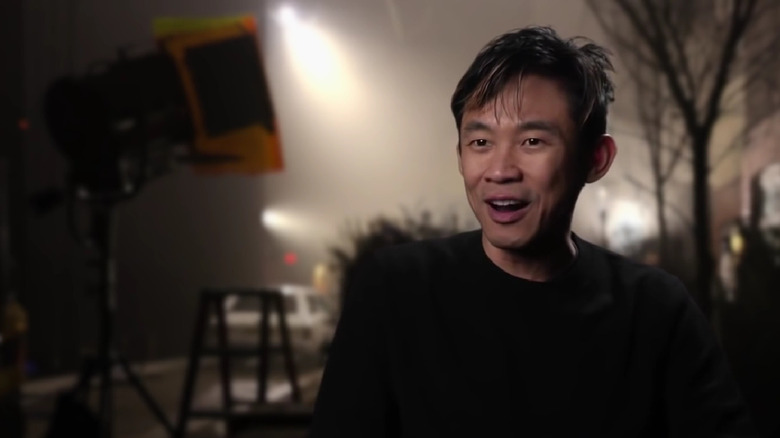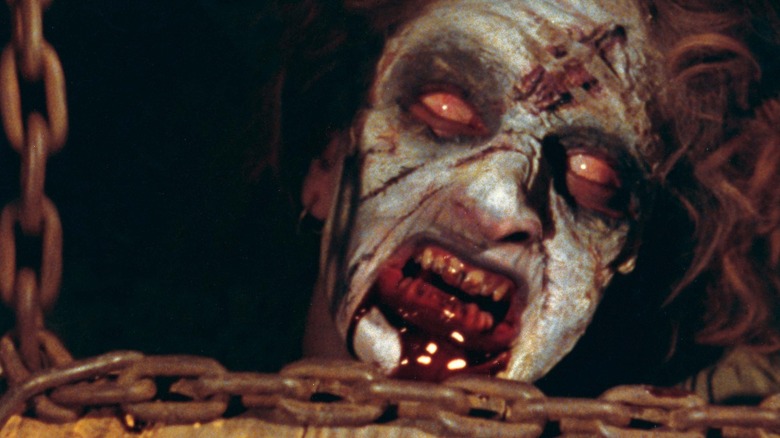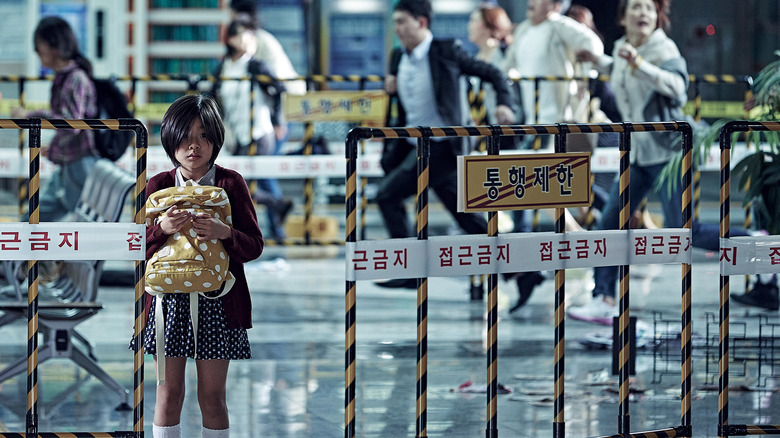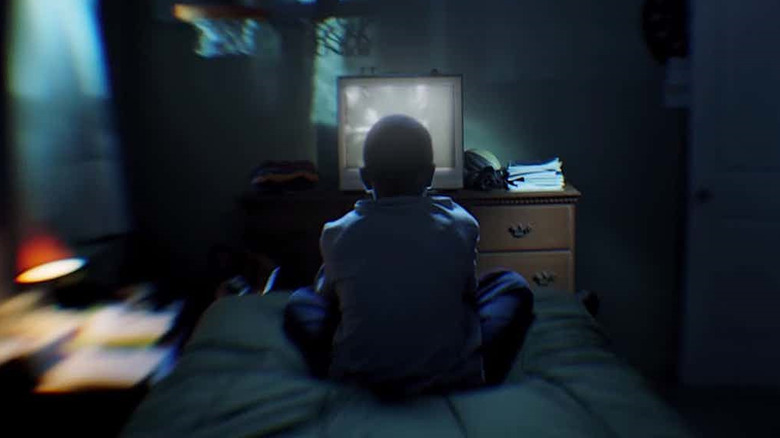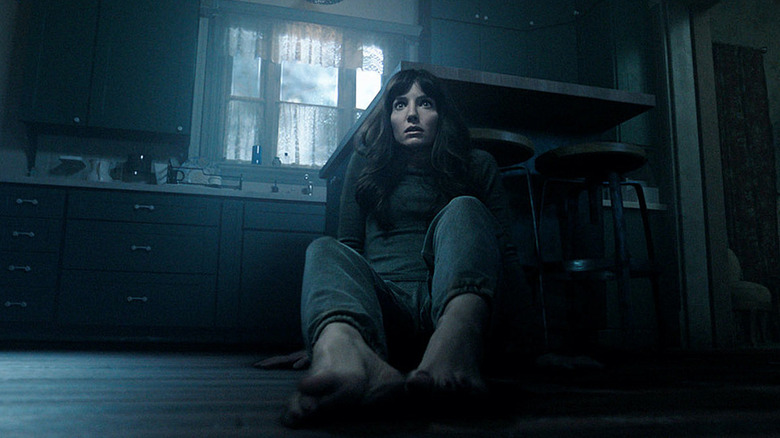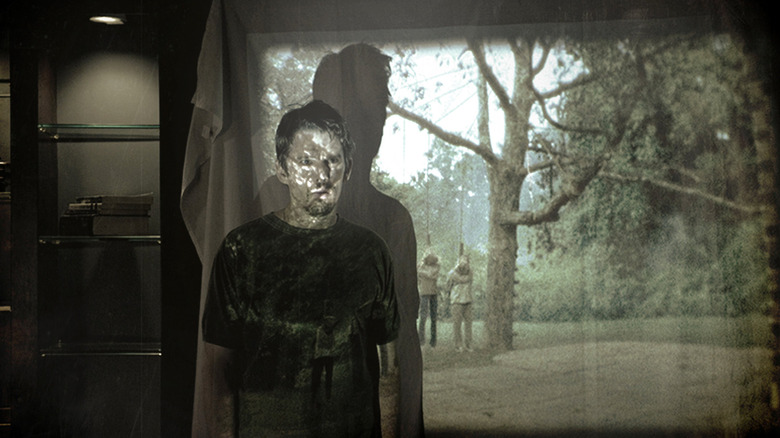James Wan Gave 5 Expert Tips For Making A Successful Horror Film, And We've Got Recs
Back in 2016 when "The Conjuring 2" was on its way to a $320,392,818 worldwide box office, director James Wan sat with Indiewire and offered five rules to follow for a commercially successful horror movie. The tips seem simple on paper: find new twists on old concepts, upend audience expectations, etc. But in practice, it can be difficult to construct a truly memorable set piece in a way that still serves the narrative and keeps things moving. If one professional aim is to tell stories that make a profit at the box office, one could do worse than Wan.
The "Saw" co-creator has been at the helm of two of the genre's most profitable franchises of the past decade, "Insidious," and "The Conjuring," as well as successfully branching beyond horror and into mainstream tentpoles like the DC-based "Aquaman" franchise. Some of the most profitable horror films of the past decade came by way of the Malaysia-born director, who's still got the magic touch: Wan's 2021 bonkers-in-Yonkers thriller "Malignant" swept up over $34 million at the box office, and as a producer, Wan has his fingers in multiple honeypots to include Netflix's highly talked-about sci-fi mystery series "Archive 81," and upcoming Stephen King adaptations of "Salem's Lot" and "The Tommyknockers." This is the man to listen to when it comes to (fictional) blood money.
Wan told Indiewire, "I'm at the point now where I want to give other young upcoming filmmakers the chance I got when I was starting out and made my first short movie 'Saw'." To help out, Wan has dropped the following tips for hungry storytellers, and we've come up with a corresponding movie recommendation for those studious note-takers in the crowd. Happy viewing!
Horror doesn't have to be expensive
The Tip: Wan's first tip is more of a creative challenge: if you can hook and thrill an audience within the confines of a low-budget picture, you've displayed crucial skills that can carry to the lofty studio projects. A shoestring budget necessitates resourcefulness, which breeds creativity. Wan says, "What I think makes the horror genre so special is that the smallest things can create a big impact. A creaking door can send chills up your spine, and it doesn't cost anything."
The Recommendation: "The Evil Dead" (1981)
Where to Find It: HBO Max
Why: After priming the pump with his short film "Within the Woods," Sam Raimi's 1981 expanded sleeper hit "The Evil Dead" turned coffee-infused theatrical blood into box office cash, purely on word-of-mouth and the coverage of Fangoria Magazine, along with and the high-profile interest of author Stephen King (known to dabble in the genre from time to time), which prompted New Line Cinema to get in on the distribution game. A cabin-in-the-woods romp with buckets of blood and a Herschel Gordon Lewis-like spirit of indie sick-making, the story itself is simple: a quintet of college students arrive at a rural Tennessee cabin for some R&R and accidentally conjure a demonic presence through an archeologist's cassette tape. They broke the cardinal horror rule — never read the Latin aloud — but their doom spelled box office boom: following a wide release by New Line, "The Evil Dead" made back several times its production budget, and got a little notoriety as a treat: Raimi's film became a Video Nasty, its home video sales banned in the United Kingdom for much of the decade. A 2013 remake followed in its stead, disgusting audiences and triggering walkouts from its screening.
Turn classic horror on its head
The Tip: One of Wan's time-honored techniques is a simple recalibration of the classic stories we all know and love. Fresh tales come from manipulating the mechanics of the old ones. "With 'Insidious,'" he says, "we wanted to tell a haunted house story that really wasn't a haunted house story at all. With 'Saw,' it was about making a small, contained horror thriller, but one that would stand out from the pack of other indie [horror] films." Indeed, one of the most-quoted lines from "Insidious" makes the twist clear: "It's not the house that's haunted ... it's your son." And this movie came out over a decade ago, so gimme a break about spoilers.
The Recommendation: "Train to Busan" (2016)
Where to Find It: Shudder, Amazon Prime Video, Tubi, Peacock
Why: Listen, we know the zombie game by now. The rules are pretty clear and entrenched, though occasionally a movie comes along that has enthusiasts debating whether zombies should run or if they have to die first in order to be a true zombie. But Yeon Sang-ho's 2016 festival of terror "Train to Busan" successfully revitalized the zed genre simply by putting zombies on a train, and throwing in a hard-hitting meditation on fatherhood to leaven the action. The premise: A father travels with his daughter aboard a train right at the nexus of a zombie outbreak, in one of only two zombie movies to ever make me sob uncontrollably (the other being Ben Howling and Yolanda Ramke's 2017 Aussie thriller "Cargo," also about a father and daughter). The movie made a domestic gross of $92,742,323 on its $8.5 million budget and, now, awaits a stateside remake helmed by gore-and-guns maestro Timo Tjahjanto. "Last Train to New York" is expected in April of 2023, with a bonus: the film is produced, among others, by James Wan's Atomic Monster Productions.
Develop great set pieces
The Tip: The seance in "Insidious." Mary Shaw's theater of creepy marionettes in "Dead Silence." The Jailhouse massacre in "Malignant." If there's one thing James Wan can conjure up, it's a logistically complex sequence that everyone will rave about for weeks, months, maybe years. Wan insists, "Your set pieces have got to be the kind of stuff that people talk about around the water cooler the morning after they've seen the movie."
The Recommendation: "Get Out" (2017)
Where to Find It: VOD, Spectrum TV, Prime Video, Apple TV, Redbox., Vudu
Why: "Get Out" is the one recommendation on this list that you'll have to shell out a couple of rental dollars for, but it's worth it. A horror movie with an eye for satire, "Get Out" concerns a young Black photographer (played by Daniel Kaluuya) who meets the family of his white girlfriend (̌Allison Williams) and they all seem to like him — but not for his great personality. An incredible commercial and critical success, Jordan Peele's feature directorial debut contains a number of fantastic set pieces, but the one that has gained the most cultural purchase around the water cooler has been Peele's conceptualization of the Sunken Place, a marginalizing prison-void that Peele says is tailor-made for every individual, and a metaphor for the Black moviegoing experience. He elaborates on the DVD special features of the movie:
The Sunken Place, among other things, it is a metaphor for the marginalization of the Black horror movie audience. We are a loyal horror movie fanbase and we're relegated to the theater, not the screen. We don't have the representation of our skin in horror films, nor do we have representation of our sensibilities and our ability to observe trouble before it happens, and our ability to excuse ourselves.
Undermine your audience
The Tip: The modern horror fan knows what to expect, especially from their favorite filmmakers. Legacy slashers like "Halloween Kills" and "Scream" (2022) have sold enough tickets to prove that horror is still a very popular and lucrative box office draw, with the understanding that certain storytelling boxes will be checked when attending these movies. There's a genre literacy that's even baked into many of these films today — this year's "Scream" entry discusses the rules of the "requel" with characters using their knowledge of scary movies to determine the potential victims and suspects, while Josh Ruben's "Scare Me" interrogates horror storytelling itself. Wan echoes the sentiment with encouragement to keep viewers on their toes. "If they're expecting something to happen, what can you do to undermine that expectation?" Wan said. "I'm always trying to find new ways to break an audience's expectation of the genre."
The Recommendation: "Malignant" (2021)
Where to Find It: HBO Max
Why: The natural next step is to recommend Wan's 2021 filmmaking heel-turn "Malignant," which surprised the hell out of everyone. Ostensibly a murder-mystery but revealing so much more in its nearly two-hour runtime, "Malignant" focuses on a traumatized woman plagued with violent visions of murder that spill into her reality. Within that reality are so many bonkers-in-Yonkers twists and moments that it's best to go in as cold as possible. For his part, Wan maintains the ideal that directors shouldn't let themselves get too used to one thing, telling /Film:
"I'm very aware of the reputation that I have built for myself in the horror genre in recent years, and I'm always trying to find new ways to reinvent myself so that I don't get stale, so to speak. Or rather, I don't want peoples' perception of me to get stale. I don't want people to keep thinking, 'Oh, James is just doing the same thing again and again because he's able to do it. He does it well, and that's all he does.' And I hate that. And so part of the reason, too, why I wanted to make Malignant was that I want people to know that this is not a jump scare film. And I worked very hard to make a movie that doesn't really have my traditional jump scares because it's not that kind of a movie."
Appeal to primal human fears
The Tip: Fears of the dark are pretty universal, whic is why James Wan fell in love with David F. Sandberg's treatment for "Lights Out," a feature-length version of his 2013 short film of the same name. "Growing up, we all had all kinds of childhood fears that can kind of make for an acid flashback," Wan said. "Lights Out" plays right into this principle by focusing on a classic fear that lots of people have–darkness. "That's the genius of 'Lights Out. If it came out in the '80s or early '90s and I'd gone to the video store and discovered this little gem of a horror film, it would have stayed with me forever."
The Recommendation: "Sinister" (2012)
Where to Find It: Tubi, Hulu
Why: Ever held a genuine, illogical fear that what you're watching will come out of the tv and getcha? We've all been there, maybe even slept with the lights on a time or two after a late-night horror movie. "Sinister" leans into this fear and provides genuine scares with the story of a true crime writer (Ethan Hawke) who moves his family into a house that was previously the scene of a brutal murder. In his investigation (which will provide the research for his next book), the author discovers a cache of Super 8 home movies, with a supernatural force seemingly attached to them. Screenwriter C. Robert Cargill came up with the story after watching another movie that has villains popping out of screens, Gore Verbinski's "The Ring." Cargill spoke about dreaming of watching Super 8 films in his attic, and what it led to:
"So I wake up terrified and that image haunted me for years and I knew I had to do something with it. So I crafted the story around and created the mythology of Sinister. What's really interesting is people are telling me they have nightmares and that says something about the art – that I've taken this nightmare and caused other people to have the same nightmare. That's such a cool concept."
